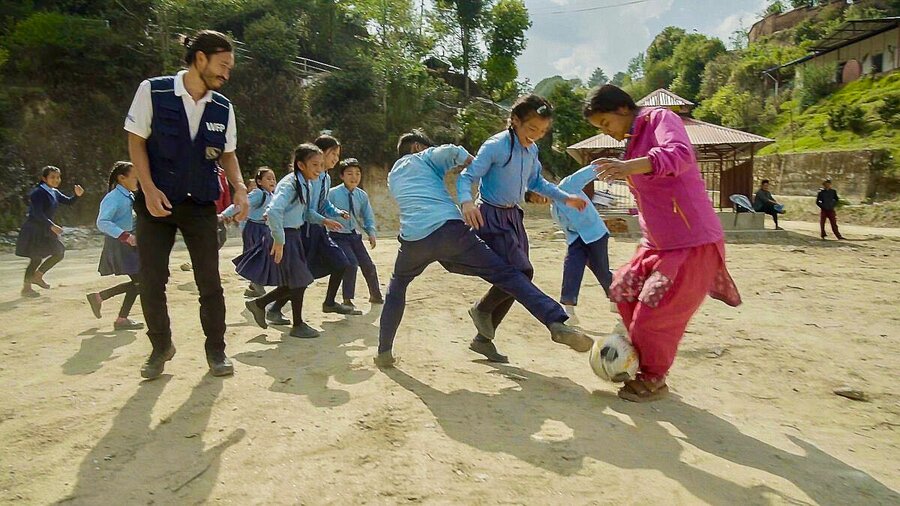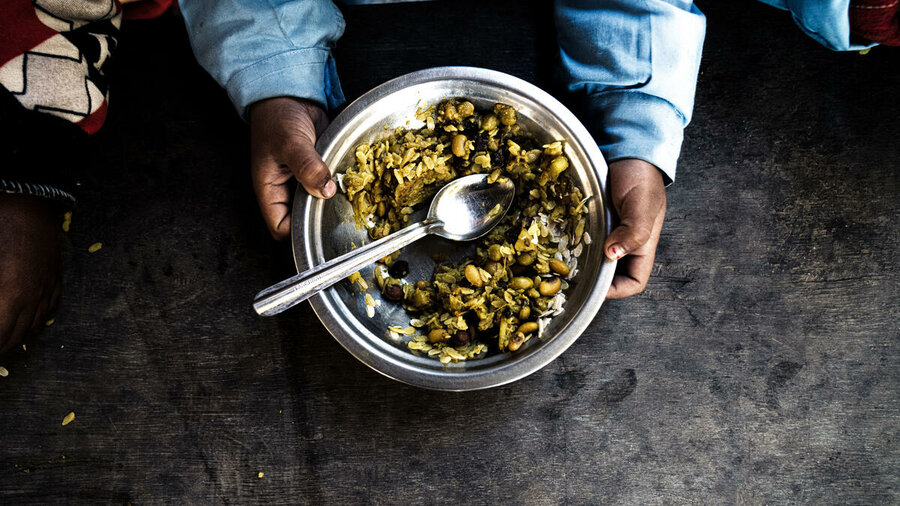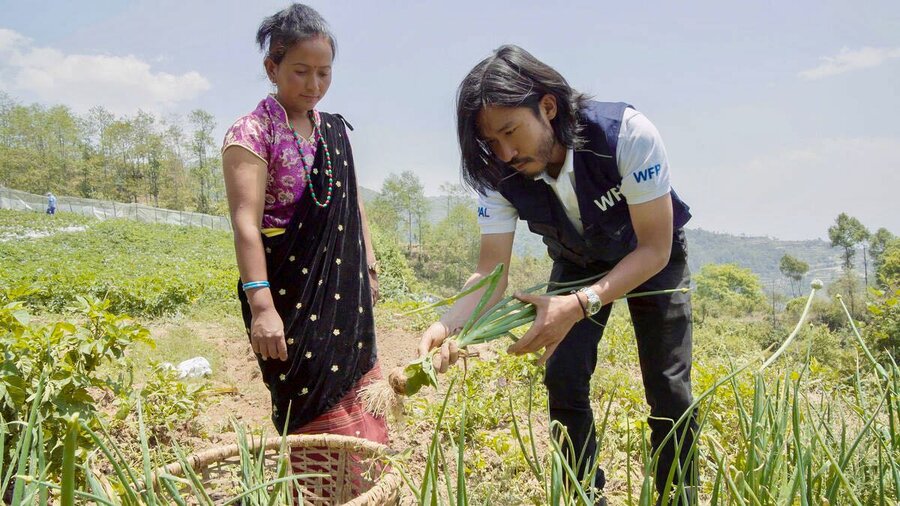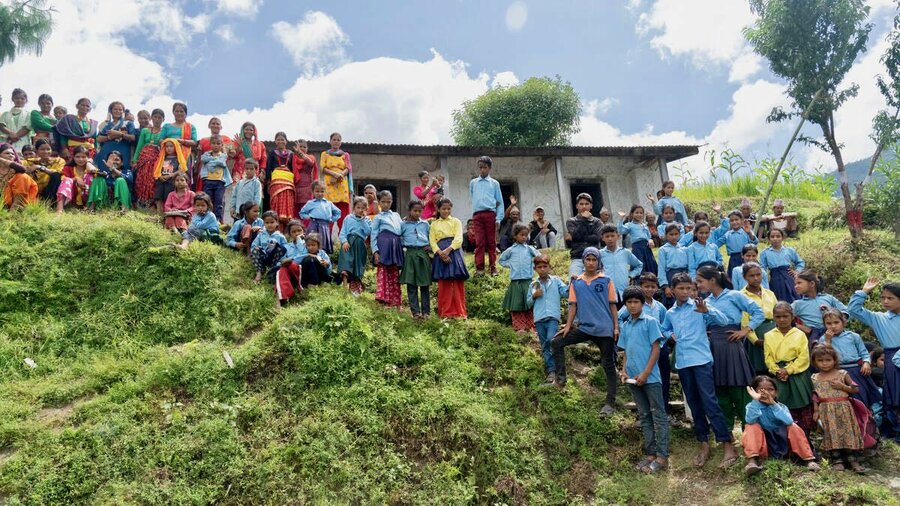Nepal scores a goal against hunger

A tattered football sails off the field at Shree Kakani Ganesh Primary School, in the central Nepalese village of Kakani. The game pauses, as 12-year-old team captain Ravi stops and strains his ears. The school bell is ringing, signalling the end of the gym class and summoning the players to lunch.
“We never miss school meals as it gives us the energy for after-school sports,” says Ravi’s best friend, Nabin, 11, as the two walk over to the end of the playground that stands on a tall ridge. Clusters of houses and terraced farmland dot the mountains below.
Here, in one of Asia’s poorest countries, children like Ravi and his fellow students often walk for hours to get to school or miss it entirely. With more than one-fourth of Nepal’s children under 5 suffering from malnutrition – which can leave lasting effects when they get older – World Food Programme (WFP)-supported school meals can be a game changer.
The meals are also part of a broader effort to give young school children a healthy start. Under WFP’s Home-Grown School Feeding initiative, supported by governments like Japan and the United States, raw ingredients for the lunches at Ganesh primary are sourced from local smallholder farmers, who make up two-thirds of Nepal’s workforce.

Now, nearly half a century since school meals debuted here, The Government of Nepal has largely taken over the programme, with WFP providing technical assistance – a transition that will be completed next year. That means local authorities – who receive the school meals budget from the federal government – along with local communities - who supply the cooks, farm-raised food and oversight - will largely run the show.
“Embedding the management of the school feeding programme in the local community is key to its sustainability,” says WFP Country Director Robert Kasca.
Curry for lunch
Next to the playground of Ganesh primary sits a small, tin-roofed hut equipped with gas stoves and liquified petroleum gas cylinders, where cook Pratibha Tamang is vigorously scrubbing up.
“The new kitchen makes my job easier as I can refrain from using firewood and the concrete floor picks up less dirt than the ones covered in mud,” Pratibha says.
Simmering in her pots are kheer, a traditional rice pudding made from fragrant rice boiled in milk and sugar. These will be served with warmly spiced curry, prepared with black-eyed beans, onions and potatoes. They have been sautéed and simmered, and will soon be spooned into plates.

“Cooking for me has always been a joyous experience,” says Pratibha, adding that students get a different meal every day. Her two children, now 12 and 14, also ate midday meals at the school a few years ago.
“Since we started serving cooked hot meals from last August and ensured proper handwashing and hygiene facilities, far fewer students complain of illnesses or are absent,” she adds.
In 2022, WFP directly provided school meals to more than a quarter-of-a-million children in nearly 2,500 schools countrywide. But we are gradually helping transition districts to a cash-based national school meals programme, which supplies local authorities and schools with cash so they can buy their own ingredients.
As WFP reduces funding for Nepal’s school meals, the Government is stepping up – almost quintupling its budget for the programme between 2017-2022 alone.

Meanwhile, WFP continues to provide authorities with technical support to roll out home-grown school meals. The initiative sources food from local farmers like Krishna Maya, who grows onions, pumpkins, gourds and strawberries on a plot of land across from Ganesh Primary.
“As we live in a difficult terrain where food is scarce,” she says, “I work hard to ensure that the small patch of land that I own yields enough for my family.”
Markets for farmers
Like most of Nepal’s farmers, Krishna cultivates less than a hectare, which keeps her family at barely subsistence level. She sells her surplus harvest to the school through a women’s cooperative, earning much-needed income for her family.
“School meals provide a secure market for local farmers, increasing their incomes and strengthening the local economy,” says Suman Tamang, chairman of Kakani Rural Municipality, where Ganesh primary is located.
For the students, he adds, “it means awareness of the importance of a nutritious diet and healthy eating habits. For women, it means earning their own money, and valuing themselves more.”
WFP findings also show a drop in gender- based violence in families where financial stress is reduced.

“My earnings have lifted a huge burden from my husband’s shoulder,” says another female farmer, Parvati Tamang, whose husband works as a farm labourer. “We have more peaceful nights, we quarrel less on petty issues.”
When school wraps up in the afternoon, the football match resumes at Ganesh primary. Because it is a Friday, teachers and other school staff join the game. Their families and younger children join the fan club cheering them on.
“Even though Nepal hasn’t made it to the World Cup, football is definitely our national game,” says team captain Ravi.
